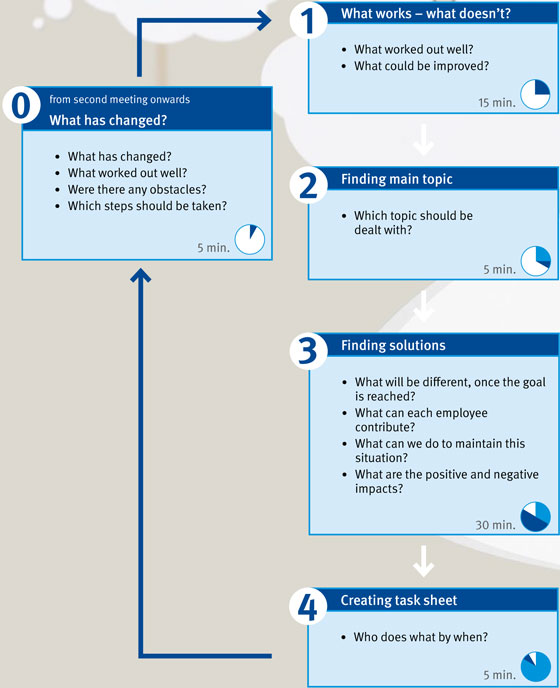Abschnitt 3 - 3 How are the meetings structured?
Step: 1
What works - what doesn't? (approx. 15 min)
(approx. 15 min)
Every participant answers the following questions:
What worked out well in the past?
What could be improved?
Step: 2
Finding main topic (approx. 5 min)
(approx. 5 min)
One topic should be selected from the proposed improvements. The selection can be decided by vote.
Central question:
Which topic is the most essential and should be discussed first?
Step: 3
Finding solutions (approx. 30 min)
(approx. 30 min)
Every participant answers the following questions:
What will be achieved/different, once we have reached our goal?
e.g. "tools are always at the designated place" (express it positively!).
What can each employee contribute today or tomorrow to reach the goal?
e.g. "I immediately return tools no longer needed" (proactiveness).
What can we do to maintain this situation?
e.g. "We check and optimize the existing organizational system. We procure new mountings and cabinets." (short and medium term planning)
What are the positive and negative impacts of reaching the goals?
e.g. positive: "It is quicker", negative: "Everybody must be disciplined."
Step: 4
Creating task sheets (approx. 5 min)
(approx. 5 min)
Results are specified in writing: Who does what by when?
Follow-up meeting (from second meeting on wards)
Step: 0
What has changed since the last brainstorming meeting? (approx. 5 min)
(approx. 5 min)
The persons responsible provide information on changes.
Central questions:
What has changed or what have I achieved?
What worked out well?
Which obstacles occurred?
Which steps should be taken?
The measures to be taken are documented in the tasks sheet.
Proposed solutions which could not be implemented should be discussed again (step 3).
How are the meetings structured?

